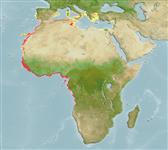Classification / Names
Common names from other countries
Main reference
Size / Weight / Age
Max length : 100.0 cm TL male/unsexed; (Ref. 27584); common length : 60.0 cm TL male/unsexed; (Ref. 3397); max. published weight: 3.2 kg (Ref. 40637)
Environment
Marine; pelagic-neritic; depth range ? - 70 m (Ref. 2683)
Climate / Range
Subtropical, preferred 24°C (Ref. 107945); 42°N - 13°S, 19°W - 36°E
Distribution
Short description
Dorsal
spines
(total): 8;
Dorsal
soft rays
(total): 20-22;
Anal
spines: 3;
Anal
soft rays: 18 - 20. Diagnosis: body deep and strongly compressed, becoming elongate with growth (body depth comprised from 1.3 to 1.8 times in fork length); dorsal profile abrupt; mouth large, upper jaw ending below posterior half of eye; dorsal fin with 7 spines, becoming resorbed and indistinct at about 150 mm fork length, followed by 1 spine and 20-22 soft rays; anal fin with 2 spines, becoming resorbed and indistinct at very small sizes, followed by 1 spine and 18-20 soft rays; 1st dorsal- and anal-fin rays extremely long and filamentous in young individuals, becoming shorter in adults; pectoral fins falcate, longer than head; pelvic fins elongate in young individuals; scales very small and cycloid, hardly visible, absent on some parts of head and body; straight part of lateral line with 4-20 scutes; base of caudal fin with bilateral paired keels (Ref. 57392).
Coloration: silvery, with a faint metallic-blue tint on upper third of body and head; juveniles with 5 dark crossbars on sides (Ref. 57392).
IUCN Red List Status (Ref. 115185)
Threat to humans
Harmless
Human uses
Fisheries: minor commercial; gamefish: yes
More information
ReferencesAquacultureAquaculture profileStrainsGeneticsAllele frequenciesHeritabilityDiseasesProcessingMass conversion
Tools
Special reports
Download XML
Internet sources
Estimates of some properties based on models
Phylogenetic diversity index
PD50 = 0.6250 many relatives (e.g. carps) 0.5 - 2.0 few relatives (e.g. lungfishes)
Trophic Level
3.6 ±0.59 se; Based on food items.
Resilience
Medium, minimum population doubling time 1.4 - 4.4 years (Assuming tm=3-4)
Vulnerability
Moderate to high vulnerability (51 of 100)
Price category
